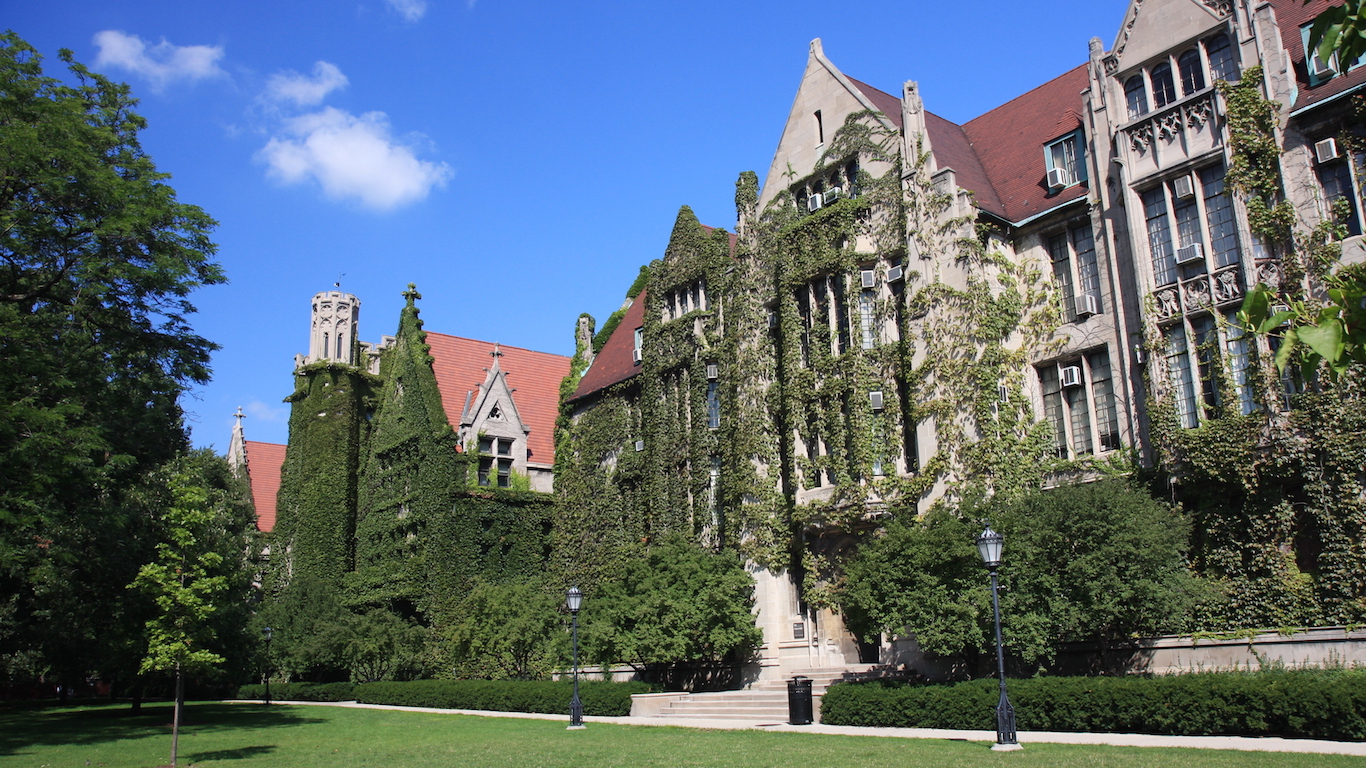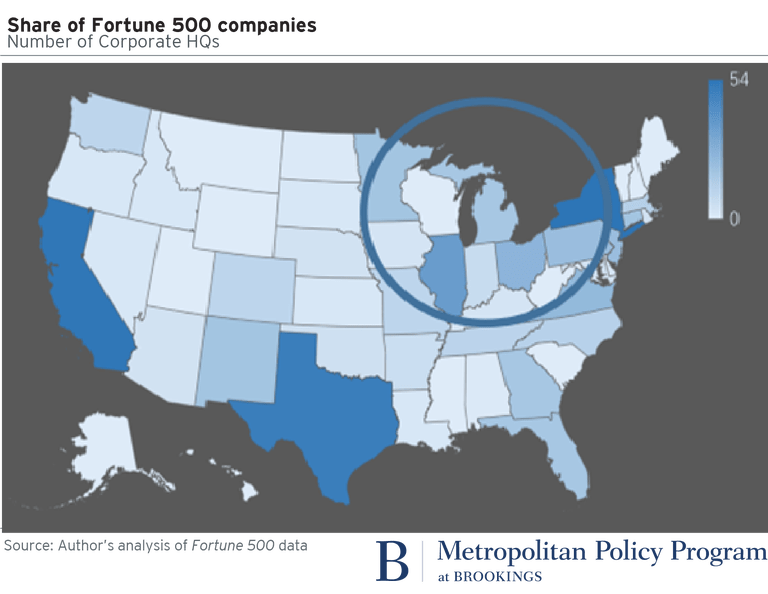Economy
The Rust Belt Needs Capital to Turn Talent and Innovation Into Jobs

Published:
Last Updated:

By John C. Austin, nonresident senior fellow in the Metropolitan Policy Program at the Brookings Institution
Since Rust Belt voters tipped the results of the 2016 election, interest in effective strategies for supporting new business and job growth in this important region has intensified.
Such interest recognizes that the states of the upper Midwest share more than their swing state status. A unique economic and social development storyline unites the industrial heartland, extending across all or part of 12 states from Minnesota and Missouri in the West, through the Great Lakes and up the Ohio River Valley to Western New York, and to Pennsylvania and West Virginia in the East. The region has many economic challenges, but also boasts important economic strengths, perhaps none as important as the tremendous innovation and talent emerging from its companies and universities.
Yet a lack of risk capital in the Rust Belt has held back the region’s capacity to translate its formidable innovation and talent assets into new businesses and jobs. That’s beginning to change, but public policies could do much more to accelerate the development of a robust innovation infrastructure equal to the Midwest’s potential.
The Midwest’s significant innovation assets are gaining more attention
Home to more than 200 of the nation’s Fortune 500 companies and 20 of the world’s top 200 research universities, the upper Midwest generates 26 percent of the nation’s corporate and university patents and 31 percent of its university-based research and development. The latter includes more than one-third of the nation’s highly competitive National Institutes of Health (NIH) research funding, key to the creation of new drugs and medical technologies.


The power of these assets to drive local technology-based economic development, and contribute to a modern, post-Rust Belt economic reality and storyline, is increasingly evident across the region. According to commercial real estate services firm CBRE, three of the top 10 fastest-growing Tech Talent Markets in North America in 2018 were Madison, Wisc. (#3), Pittsburgh (#5), and Cleveland (#8). Similarly, innovation guru Ian Hathaway’s latest report on startup communities notes Columbus, Ohio and Indianapolis among those continuing to expand, with Pittsburgh, Madison, and Ann Arbor, Mich. among those rising faster than national peers. The presence of top-flight research institutions and universities in these same markets (e.g., University of Wisconsin, Carnegie Mellon, Ohio State University, University of Michigan, and Cleveland Clinic) is no coincidence. PitchBook finds that the presence of highly ranked research universities and top-tier colleges is one factor behind Michigan and Pennsylvania’s strong performance on talent retention.
These positive trends reflect the increasing return to the region of capital and talent that once fled to the coasts for opportunity. Entrepreneurs and investors, including coastal venture capitalists and wealthy regional “ex-pats,” are discovering and investing in the talent, ideas, and technologies generated in the region. Techstars’ Ted Serbinski, who operates out of Detroit, tells Crain’s Detroit, “This is arguably one of the most talented regions in America, churning out the most real, revenue generating businesses. None of these social networks that will ‘figure it out later.'” Serial Silicon Valley entrepreneur Steve Blank notes, “Silicon Valley is out of A players. Don’t start your company here. Start it in Ann Arbor. You won’t find the talent you need here. It’s in Ann Arbor.” And Ohio Innovation Fund manager and Silicon Valley refugee Bill Baumel writes in Venture Beat, “I see more ‘Silicon Valley-quality’ companies [here] in medical technology, cybersecurity, data science, and advanced manufacturing that have grown over 100 percent annually to tens of million in revenue with sights on $100 million, and have more prominent customers including a majority of the Fortune 500 and leading universities.”
Some investors are giving the Midwest a closer look for reasons beyond the region’s strong fundamentals. The results of the 2016 election prompted many to see how they could contribute to the economic, cultural, and political transformation of the Rust Belt. This theme helps animate Steve Case and JD Vance’s Rise of the Rest Fund, as well as former Microsoft CEO Steve Ballmer’s significant new investments in Detroit. These investors and others also worry that tech giants who are trapped in the Silicon Valley bubble are isolated from large swaths of the nation’s people and politics, and risk blame for its woes. As the Dallas Morning News argues:
By locating in emerging tech hubs outside Silicon Valley, leading venture capitalists could gain a measure of protection against changing politics. In an earlier era, the military and its industrial complex mitigated political risk by opening bases and plants in congressional districts across the country. Moving could also serve as a form of patriotic economic development if it meant investing in “comeback cities” of the Heartland such as Detroit, St. Louis, or Youngstown, Ohio.
This interest is translating into new multimillion dollar funds closing across the Midwest, with participation by significant coastal investors. The region is also seeing some attention-grabbing “Silicon Valley-like” exits. Ann Arbor-Detroit’s Duo Security, which recently went public as one of the region’s few billion dollar “unicorns,” just sold to Cisco Systems for $2.3 billion, minting new local millionaires and promising further new technology development ripple effects.
The region still isn’t living up to its innovation potential
Despite all this interest and activity, the Midwest’s innovation assets still aren’t translating into new businesses and jobs at the rates one might expect. Ohio Third Frontier architect Frank Samuel first detailed some of the factors behind this gap in his 2010 Brookings report, Turning Up the Heat: How Venture Capital Can Help Fuel The Economic Transformation of the Great Lakes Region. Among the dynamics he noted at the time, several remain salient:
Investments from the region’s well-endowed universities tell a similar story. The region is home to seven of the nation’s 25 “richest” universities, which sport multibillion dollar endowments. Endowment managers may not yet see enough responsible, high-return opportunities in the region for the increasing share of endowments invested in venture capital. As a result, too many of these “home-grown” dollars bankroll business and job growth elsewhere. A recent Detroit Free Press story detailed how since 1998, the University of Michigan has invested $220 million with a Pittsburgh-based money manager and $330 with Minneapolis-based hedge funds, but only $40 million with a single Detroit-based fund and no other. Their underinvestment in the region is occurring even as Midwestern state governments increasingly withdraw support for these critical institutions.
One shouldn’t overstate the importance of venture capital to broader economic growth and development. After all, only about 20 percent of public companies are VC-backed, and many successful venture-backed companies might have succeeded without that support. Yet more recent, more research-intensive companies with powerful spillover effects are more likely to have received VC backing. As Ann Arbor’s RPM Ventures Marc Weiser tells me, “Venture capital’s ‘home runs’ create dynamics much more powerful than the ‘singles and doubles’ generated by private equity or other forms of investment—creating new wealth among talented entrepreneurs that compounds and accelerates the local dynamic of continuous new business development.” Venture investing also focuses on the technologies, products, workforces, and companies of the future that can contribute to a new story about any region where these firms emerge, rebranding them as innovative and creative talent centers, rather than industrial backwaters. This is a story the “Rust Belt” very much needs and wants to tell.
New strategies could turn up the heat for venture investment in the upper Midwest
Several states in the Midwest are trying to change the equation. They are creating state-backed funds and seeding regional early-stage capital support organizations to help commercialize more of the region’s innovation locally.
Another idea whose time may have come is the creation of a Great Lakes-wide fund or fund-of-funds. Samuel first proposed this in Turning up the Heat as a vehicle to raise money from inside and outside the region to invest in smaller, well-run state and local/regional VC funds, and co-invest in promising companies. When the report was published in 2010, investors were interested in making money and spotting more deals, but there was not yet interest in the concomitant social impact of supporting economic transformation and new business and job growth in the Rust Belt.
Today, there is strong political and economic interest in the region. And the venture capital and early stage capital investment ecosystem has matured and grown, with more smart VC managers and others making successful investments, and more entrepreneurs starting promising enterprises. These dynamics make the potential financial success of a regional fund more likely today than earlier in the decade.
I’ll be exploring the potential for such a fund in a new Brookings-Chicago Council on Global Affairs project (with support from a team of Executive MBA students from University of Michigan’s Ross School of Business) over the next several months. We will be facilitating discussions with key informants and interested parties to assess the feasibility and identify practical steps to develop such a fund. It could be a key strategy to catalyze new job and business growth in the upper Midwest, help more of its workers find a place in a changing economy, and modernize the narrative of a region that is truly one of the world’s leading innovation engines.
An edited version of this piece, More Capital Can Translate Prodigious Rust Belt Innovation into New Heartland Businesses and Jobs, has also been published by the Chicago Council on Global Affairs where John C. Austin is a nonresident senior fellow, Global Midwest.
This post was originally published at the Brookings Institution website on August 14, 2018.
After two decades of reviewing financial products I haven’t seen anything like this. Credit card companies are at war, handing out free rewards and benefits to win the best customers.
A good cash back card can be worth thousands of dollars a year in free money, not to mention other perks like travel, insurance, and access to fancy lounges.
Our top pick today pays up to 5% cash back, a $200 bonus on top, and $0 annual fee. Click here to apply before they stop offering rewards this generous.
Flywheel Publishing has partnered with CardRatings for our coverage of credit card products. Flywheel Publishing and CardRatings may receive a commission from card issuers.
Thank you for reading! Have some feedback for us?
Contact the 24/7 Wall St. editorial team.